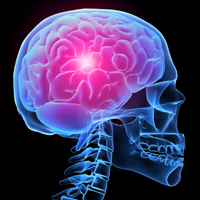Article
Taking the Guesswork Out of Concussion Tests
Author(s):
New technology uses the eyes to assess brain injuries in student athletes.

Every fall, Saturday night crowds come out for the weekly UC Davis football game and likely witness the star running back getting rattled by a hard tackle. The team physician faces a decision: keep the player in the game and risk serious head injury or pull him and face the wrath of the player, the coach and the crowd. What team physicians need is a way to accurately assess the player’s brain health status — right now.
The problem intrigues Khizer Khaderi, a neuro-ophthalmologist who is applying his expertise in the eye-brain connection to investigate traumatic brain injury (TBI) in collaboration with UC Davis physicians and Athletics department. Whether the result of a car accident, explosion, skiing, or a tackle, TBI can affect vision, memory, and even mental health.
Imperfect solutions
Khaderi began developing a mobile system that would take the guesswork out of assessing an on-field concussion, a mild form of TBI that can lead to serious, long-term brain injury, when he was director of neuro-ophthalmology and founder and director of the Sports Vision Laboratory at UC Davis. His goal was to more objectively measure a potential TBI by recording how athletes’ eyes, pupils and brains reacted to specific tests that assess the eye-brain connection. It’s an approach that could one day replace the array of more subjective neurocognitive and muscle strength tests that many teams use now.
In the fall of 2015, Khaderi and colleagues began testing the new system as part of a clinical trial on the UC Davis football field. For the study, physicians and athletic trainers test athletes immediately after a sports injury to assess how their brain function compares to established norms.
“This is what I consider groundbreaking research,” said study principal investigator Melita Moore, head team physician for athletics and assistant professor of physical medicine and rehabilitation at UC Davis. “Right now, whatever an athlete tells me is what I have to go on with regard to concussion, because you cannot see concussion.”
With traditional concussion testing, team physicians and athletic trainers ask an injured athlete a number of questions and compare the answers to the athlete’s baseline results recorded earlier. However, with players’ strong incentives to stay in the game, some have learned to circumvent the system.
“One of the problems with the neurocognitive approach is that it’s very subjective,” said Khaderi. “Players will intentionally do poorly on the baseline test, so if they do get injured, it won’t look as severe.”
Khaderi’s solution focuses on the eyes. Up to two thirds of the brain is devoted to the visual system, making the eyes an ideal window on brain health. Several biometric tests exist, but Khaderi’s team has found that relying on three established biometric tests greatly increases the chances of accurately assessing TBI risk on the field in real time.
Eyes, pupils and brain waves
Using eye movements to assess TBI has advantages. For example, researchers have measured how long the eye takes to move from a central to peripheral focus. This would be the motion a driver would make when shifting attention from the road to a child crossing it. This motion takes less than seven-tenths of a second for a healthy person, but much longer for those who’ve experienced a brain injury.
The opposite motion is also informative. In the same scenario, the driver could make the decision to look away from the child stepping into the road.
“The natural reaction is to look at the child,” said Khaderi, “but instead you look away. This involves cognition, so this type of eye movement is a good measure of executive function.”
Pupil function can also measure an injury’s severity. A coach could use a flashlight to assess dilation, but variability in lighting environments may skew results. To combat this, Khaderi adopted a psychological method based, in part, on the International Affective Picture System, which uses an index of picture types to generate consistent pupil responses.
The third metric measures brain waves. When they’re awake, people generally have a higher ratio of fast alpha waves to slow theta waves. However, that ratio is reversed after a brain injury. High theta waves indicate a dreamy state of mind.
Moving forward
Khaderi plans to bring these tools to playing fields everywhere. Fortunately, much of this technology is inexpensive and available for entertainment and other purposes. These tools can be repurposed for TBI detection.
“Our goal is to create a platform that integrates commercially available eye tracking hardware and EEG (brain wave) systems,” said Khaderi.
The ultimate goal is to create a system that could be accessed through a tablet computer or other device that could be used to evaluate anyone with a potential concussion or TBI.
“These injuries don’t just strike kids who are playing sports, but anyone who leads an active life,” said Khaderi. “Our brains are precious and we need to do all we can to protect them.”
UC Davis experts in physical medicine and rehabilitation, sports medicine and neuropsychology provide complete care for all forms of traumatic brain injury (TBI) — from mild to severe. Treatment plans are personalized based on the causes of the injury and specific symptoms. Call 916-734-6805 for information about sports-related TBI (including concussion) treatment and return-to-play evaluations or 916-734-7041 for information on non-sports-related TBI evaluation and treatment.
More stories about TBI research and treatment at UC Davis:
UC Davis expands medical response capabilities for student football players
A conversation with Concussion's Bennet Omalu
Omalu shares personal lessons from Hollywood
New tool to help coaches, team physicians assess head injuries in football




